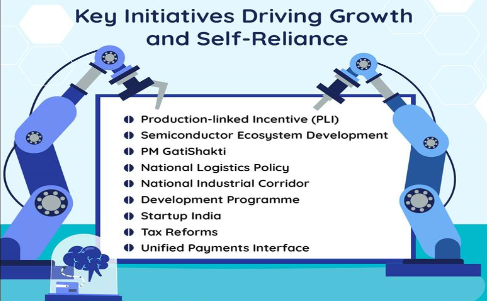Syllabus: GS3/ Economy
Context
- On September 25, 2014, the “Make in India” initiative completed 10 years as a pivotal step in India’s nation-building efforts.
Pillars of ‘Make in India’
- New Processes: The “Make in India” initiative identified ‘ease of doing business’ as a crucial factor for promoting entrepreneurship.
- New Infrastructure: The government focused on developing industrial corridors and smart cities, integrating state-of-the-art technology and high-speed communication to create world-class infrastructure.
- New Sectors: Foreign Direct Investment (FDI) was significantly opened up in various sectors including Defence Production, Insurance, Medical Devices, Construction, and Railway infrastructure.
- New Mindset: The government embraced a role as a facilitator rather than a regulator, to foster a collaborative environment that supported industrial growth and innovation.

| Production linked Incentive (PLI) Schemes – The Schemes were introduced to enhance the country’s manufacturing capabilities and boost exports with an outlay of ₹1.97 lakh crore. – It covers 14 key sectors aimed at fostering investment in cutting-edge technology and promoting global competitiveness. PM GatiShakti – Launched in 2021, PM GatiShakti is a strategic initiative aimed at achieving Aatmanirbhar Bharat and a US $5 trillion economy by 2025 through the creation of multimodal and last-mile connectivity infrastructure. – It is driven by 7 engines, namely: Railways, Roads, Ports, Waterways, Airports, Mass Transport, Logistics Infrastructure. Semiconductor Ecosystem Development – The Semicon India programme was approved in 2021, encompasses four key schemes: 1. Modified Scheme for Setting Up Semiconductor Fabs in India 2. Modified Scheme for Setting Up Display Fabs in India 3. Modified Scheme for Setting Up Compound Semiconductors, Silicon Photonics, Sensors Fabs, and Discrete Semiconductors, along with Semiconductor Assembly, Testing, Marking, and Packaging (ATMP) / OSAT Facilities in India 4. Design Linked Incentive (DLI) Scheme. National Logistics Policy (NLP) – Launched in 2022, the Policy targets reducing logistics costs, improving India’s Logistics Performance Index ranking to among the top 25 countries by 2030, and developing a data-driven decision support system. Industrialization and UrbanizationThe National Industrial Corridor Development Programme is India’s most ambitious infrastructure initiative, aiming to create “Smart Cities” and advanced industrial hubs. Startup India – Launched 2016, the Initiative aimed at supporting entrepreneurs, and building a robust startup ecosystem. – India boasts the third-largest startup ecosystem in the world, with 148,931 DPIIT Recognized Startups, which have created over 15.5 lakh direct jobs. |
Major Achievements under Make in India
- FDI inflows have steadily risen, starting from $45.14 billion in 2014-15 to a record $84.83 billion in 2021-22.
- India made remarkable progress in improving its business environment, climbing from 142nd in 2014 to 63rd in the World Bank’s Doing Business Report (DBR) published in October 2019 before its discontinuation.
- India recorded merchandise exports worth $437.06 billion in FY 2023-24, reflecting the country’s growing role in global trade.
- The textile industry has created a staggering 14.5 crore jobs across the country, significantly contributing to India’s employment landscape.
- Vande Bharat Trains, India’s first indigenous semi-high-speed trains, are a shining example of the success of the ‘Make in India’ initiative.
- India became a major exporter of life-saving vaccines to many developing and underdeveloped countries across the world.
- India’s electronics sector has experienced rapid growth, reaching USD 155 billion in FY23.
What are the concerns?
- The share of manufacturing in India’s GDP was 17.3 percent in 2013-14, and it was still stagnant at 17.7 percent in 2023 far from the target of 25% by 2030.
- The share of the manufacturing sector in total employment in the country has marginally declined from 11.6 percent in 2013-14 to 10.6 percent in 2022-23.
- India’s exports as a share of GDP has fallen from 25.2 percent in 2013-14 to 22.7 percent in 2013-24.
- Exports are also relatively concentrated in goods and services that tend not to be labor-intensive.
Conclusion
- As the “Make in India” initiative celebrates its 10th anniversary, it stands as a testament to India’s determination to reshape its manufacturing landscape and enhance its global standing.
- Though the efforts and achievements fall short when the fundamental indicators of the manufacturing sector show lackluster growth, With strategic reforms, investment-friendly policies, and a strong focus on infrastructure development, the initiative has significantly enhanced India’s industrial capabilities.
Source: PIB
Previous article
Global Initiative on Digital Health
Next article
News In Short-26-09-2024